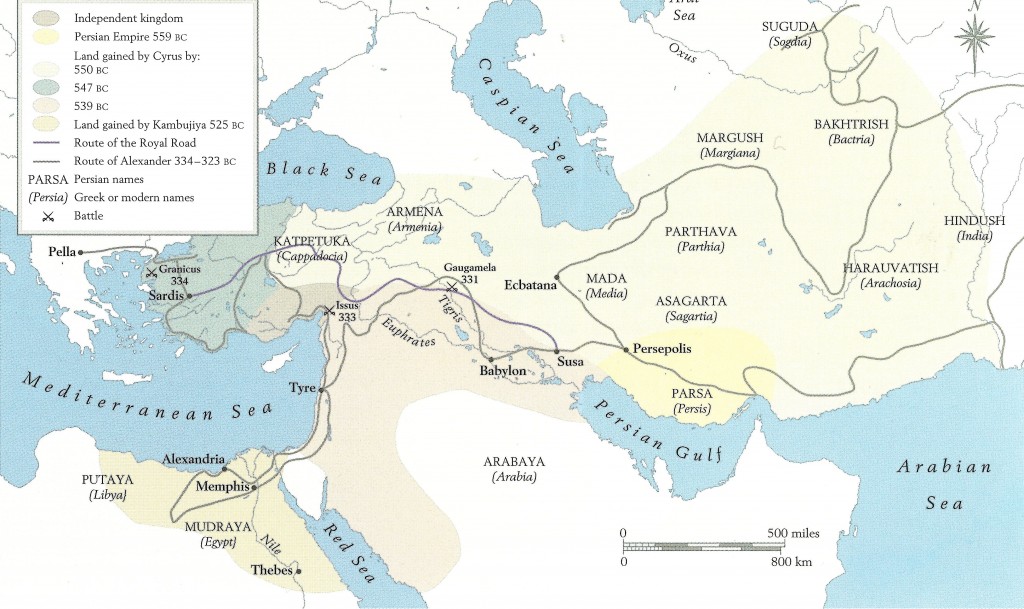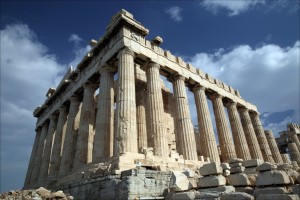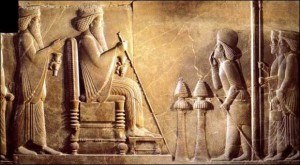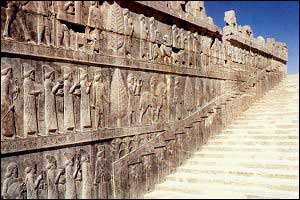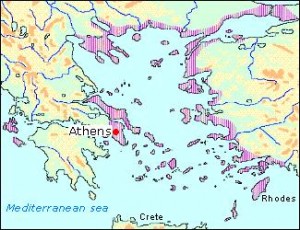The article below on the Persian influence on Greeceis by Janine Bakker:- this article was originally posted by the Iran Chamber Society. Kindly note that numbers of pictures inserted into the Helmut Nickel article below are from Kaveh Farrokh’’s lectures at the University of British Columbia’s Continuing Studies Division and Stanford University’s WAIS 2006 Critical World Problems Conference Presentations on July 30-31, 2006).
=====================================================================
As noted by the Iran Chamber Society:
The ancient Persian and Greek cultures did not exist in isolation. There was cross-fertilization. The present article contains a description of Persia’s influence on Greece.
Introduction
The first part of this article is not to read, but to look at:
In front of us, we see the extensive Achaemenid empire (green), stretching from the Indus in the east to the Mediterranean Sea in the west. Beyond the Aegean Sea, almost at the left edge of this map, we see a green area that consists of several islands and city-states, which have not yet decided whether they are one country or not. That is Greece.
Now it is remarkable that there have been more scholars who have studied the fuss and bustle on the northwestern border of the Achaemenid empire than researchers who have analyzed the world power itself. Of course, there are good reasons for this situation. Greece is relatively close to western Europe, where it had, since the age of the great art historian Johann Joachim Winckelmann (1717-1768), a more or less privileged status as the cradle of western civilization. Another reason is that the impressive Greek collection of literary, scientific and other texts has survived, whereas there is no such collection from Persia. (The collection of religious texts known as the Avesta dates from the fifth or sixth century CE.) Moreover, in their historical writings, the Greek authors make it clear that the Persians are a mere bunch of decadent, effeminate barbarians, natural slaves that could be ignored in the history of mankind. The Greeks themselves had the best culture and there was simply nothing that other civilizations could add. Western scholars have long accepted this judgment.
This almost hostile attitude has long existed in Europe, together with a fascination for all that was strange and unknown, such as the mysterious Orient. Because of this combination of fascination and suspicion, questions about the exact interaction between the two cultures are not only interesting, but also necessary. One must see further than the end of one’s nose.
When one studies the past, it is important to understand that no event, nation, or culture exists in isolation. Empires, ideas, and societies are formed by the empires, ideas, and societies surrounding them. It is the conviction of the author of this article that exchange always exists, albeit on different levels and with varying intensity. Even when those involved deny this influence. (Perhaps a strong denial even represents a strong influence. Otherwise, it would not be necessary to deny influence.)
Let’s return to the Greeks and Persians. Many scholars have researched Greek influence on the east, especially in the era after the conquests of the Macedonian king Alexander the Great (336-323 BCE). It is about time to to analyze the other direction of cross-cultural influence. That this remains an odd subject, is proven by the lack of literature on the subject; if the question about Persian influence is posed, it is usually in a footnote. It is, however, the main subject of the present article.
We shall discuss the question whether the Athenians, in the age after the Persian Wars (say after 479 BCE), have adapted Persian ideas on the fields of architecture and government. We shall discuss oriental influence on architecture, concentrating on the Odeon of Pericles, the Prytaneum, the Parthenon frieze, and the caryatids. After this, we will investigate whether there is similar influence on the management of the Athenian empire, the Delian League. But first, we will give a brief overview of the most important events during the period under consideration.
History
In 547 or 546 BCE, the Persian king Cyrus the Great conquered the region that is now called Turkey. His son Cambyses added those parts of the Levant that had not been conquered yet, and went on to add Egypt to the Achaemenid empire (525 BCE). Under his successor Darius I the Great (522-486 BCE), the Persians for the first time invaded Europe, where Thrace was subdued.
Since the days of Cyrus, the Greek towns in western Turkey -usually called the Ionian cities- belonged to the Achaemenid empire, but in 499 they decided to revolt against those that had been their rulers for almost half a century. The men who ruled the Ionian towns on behalf of the Persian kings were expelled, and the help of the mainland Greeks was invoked. Although Athens sent a considerable force to help the Ionians, the rebels were brought to heel.
According to the Greek researcher Herodotus of Halicarnassus (who may have been mistaken at this point; click here), the Ionian revolt caused king Darius to punish the Greeks who had supported the rebels. In 492 BCE, general Mardonius conquered Macedonia, and in 490 BCE, Datis and Artaphernes added the islands in the Aegean Sea. At the end of the summer, they led a punitive action against Athens, which ended in disaster in the battle of Marathon.
This battle meant a boost for the Athenian self-confidence, and the city became even stronger after the discovery of silver ore near Laurion. The new affluence was used to build a large navy.
In 480 BCE, the Persian king Xerxes (486-465 BCE) decided to avenge his father’s defeat at Marathon. With a huge army and a large navy he invaded the Greek mainland, and defeated his enemies at Thermopylae. Thessaly and Boeotia were added to the Persian possessions and Athens was captured. However, the Persian navy was badly damaged when it encountered the Greek navy in the Athenian harbor. Because at the same time the Babylonians revolted under Šamaš-eriba, Xerxes was forced to return. He left the war to general Mardonius, who sacked Athens but was defeated in the summer of 479 BCE near Plataea.
Two years later, the Athenian statesman Aristides organized the Greek towns of Ionia and the mainland that wished to continue the struggle in a new alliance, the Delian League. However, during the following decades, Athens, originally only the first among equal towns, started to regard the members of the League as its subjects. Because she was economically and military very strong, and became even more powerful because she now controlled an empire, Sparta, the leader of the other Greeks, became afraid.
In 461 BCE, war broke out. In the meantime, Athens was still at war with Persia. Sometimes, the Athenians were successful (e.g., at Eurymedon in 465 BCE), and sometimes the Persians were victorious (e.g., in Egypt in 456 BCE). For a dozen of years, the Athenians had to cope with two enemies at the same time, but in 449 BCE, the hostilities with the Persians were ended.. Three years later, Sparta and Athens concluded a treaty. This might have been the moment to dissolve the Delian League, but the Athenians refused to do so, and in spite of minor troubles, its members supported Athens in a second war with Sparta, which broke out in 431 and lasted until 421 BCE.
However, in 415 BCE, Athens attacked Sicily in the far west and supported Amorges, a rebel in the Achaemenid empire. The Sicilian expedition was a disaster, but Athens still might have survived; however, the intervention in the Persian sphere of influence led to an alliance between Sparta and king Darius II Nothus. Several member states of the Delian League now revolted, and Sparta received a powerful navy. In 404, Athens had to surrender and the League was dissolved.
Persia now regained the Ionian towns, but did not enjoy them uncontested. The Spartan king Agesilaus invaded Asia, where he remained successful until 394 BCE, when he was recalled by his government because Persia was now supporting Athens. For almost half a century, the Persians were able to retain their Asian possessions, simply by keeping the Greeks divided.
Architecture
The buildings we are about to discuss, were all built after the Persian general Mardonius had destroyed Athens in 479 BCE, and after the battles in the harbor of Athens, at Plataea and at Eurymedon, where the Greeks had defeated the Persians. The Athenians had obtained much wealth after these battles. Herodotus tells that after the battle of Plataea:
…the Greeks dispersed themselves about the Persian camp and found tents furnished with gold and silver, and beds overlaid with gold and overlaid with silver, and mixing-bowls of gold, and cups and drinking vessels [i.e., rhytons]. They found also sacks laid upon wagons, in which there proved to be caldrons both of gold and of silver; and from the dead bodies which lay there they stripped bracelets and collars, and also their swords if they were of gold, for as to embroidered raiment, there was no account made of it. [Herodotus, Histories 9.80]
When a Persian king went to war, he not only took his army with him, but many courtiers as well. In this way, he could also live like a king when he was at the front, and was able to give fitting rewards to his brave warriors.
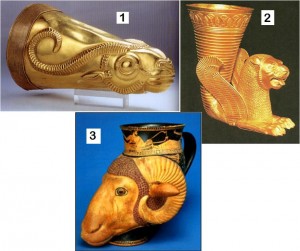 [Click to Enlarge] [1-2] Persian Rhythons – many of these were captured after the defeat of Mardonius at Plataea (479 BC) (Herodotus, 9.80)and [3] an Athenian rhyton (Museo di archeologia ligure, Genova) (Pictures 1-2 used in Kaveh Farrokh’’s lectures at the University of British Columbia’s Continuing Studies Division and Stanford University’s WAIS 2006 Critical World Problems Conference Presentations on July 30-31, 2006; Picture 3 originally posted in Iran Chamber Society).
[Click to Enlarge] [1-2] Persian Rhythons – many of these were captured after the defeat of Mardonius at Plataea (479 BC) (Herodotus, 9.80)and [3] an Athenian rhyton (Museo di archeologia ligure, Genova) (Pictures 1-2 used in Kaveh Farrokh’’s lectures at the University of British Columbia’s Continuing Studies Division and Stanford University’s WAIS 2006 Critical World Problems Conference Presentations on July 30-31, 2006; Picture 3 originally posted in Iran Chamber Society).
After the Greek victory, the booty was divided between the towns and cities that had shared in the fighting, and everybody received a fair share. So did Athens. As one of the leading powers, it must have been one of the first to choose, and as a consequence, much silver, gold, and other luxuries were brought to Athens. A simple but excellent example are the Persian rhytons (drinking vessels), which appear in Athens suddenly and in great quantities after the war. They were immediately imitated by Greek artists.
Except for precious metals, utensils and luxuries, weapons and tents were taken away from the battle field at Plataea. Especially the royal pavilion, in which Mardonius hadhad his lodgings, had the full attention of the Athenians.
Architecture: Odeon
It is certain that after Plataea, the pavilion of the great king was taken to Athens. But what happened next? It has been assumed that (a part of) it was already used in 472 BCE as decor [skênê] of the tragedy The Persians by Aeschylus. Another and more plausible suggestion -not necessarily contradicting the preceding one- is that the wooden construction was used as a music hall (odeon) and later rebuilt from stone. This can be concluded from the following words by the Greek author Plutarch of Chaeronea:
The Odeon, or music room, which in its interior was full of seats and ranges of pillars, and outside had its roof made to slope and descend from one single point at the top, was constructed, we are told, in imitation of the king of Persia’s pavilion [skênê]. This was done by Pericles’s order. [Plutarch, Life of Pericles 13.5-6]
It is not surprising that the pavilion was used as a piece of scenery or/and music room. After all, Athens had been sacked and emergency accommodation and temporary buildings are to be expected. Besides, the pavilion of Xerxes was not a family tent, but a portable palace.
When the Odeon of Pericles was excavated, it turned out to have almost the same dimensions as the so-called Hall of the Hundred Columns at Persepolis, the capital of the Achaemenid empire. The Odeon measured 68,50 x 62,40 meters and contained 9 x 10 columns; the room of the Persepolis palace had -surprise, surprise- 10 x 10 columns and measured 68,50 x 68,50 meters.
The similarity is too obvious to be coincidental. The pavilion must have been a copy of the Hall of the Hundred Columns, and the Odeon must have been a copy of this copy.
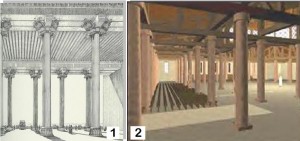 [Click to Enlarge] [1] Achaemenid Hall of 100 at Persepolis and with dimensions bearing 68,50 x 68,50 meters – 10 x 10 columns [2] Pericles’ Odeon with dimensions bearing 68,50 x 62,40 meters – 9 x 10 columns (Pictures 1-2 originally posted in Iran Chamber Society).
[Click to Enlarge] [1] Achaemenid Hall of 100 at Persepolis and with dimensions bearing 68,50 x 68,50 meters – 10 x 10 columns [2] Pericles’ Odeon with dimensions bearing 68,50 x 62,40 meters – 9 x 10 columns (Pictures 1-2 originally posted in Iran Chamber Society).
It should be noted, however, that this Persian example was not really followed in Greek and Roman architecture. The acoustics of the Odeon of Pericles must have been terrible. Later odeons, e.g. those of Agrippa, Domitian and Herodes Atticus, were little theaters and not square halls.
Architecture: Prytaneum
The prytaneum at the Athenian market (agora) was the building where the prytaneis, the executive committee of the Athenian democracy, gathered. It was built in 465 BCE. The building has the form of a circle and is very simple, without much ado. The Athenians called this building simply the tholos (’round building’) or skias (‘parasol’). It is therefore probable that the building looked like a parasol and had a round, pointed roof.
The Persian king and his satraps were often portrayed with a parasol. It has therefore been assumed that the Athenians used Persian left-behinds (e.g., a royal tent) and reconstructed it in a more durable material, retaining the original form. (The same happened when the Athenians built the Odeon of Pericles.) This assumption gains credit when we take into account that round buildings were extremely rare in the period before the Athenian prytaneum was built. There were, of course, round buildings, but they were always surrounded by stoas – something that is certainly not the case with the tholos.
Again, we may assume that the Athenians used the Persian spoils. And again, the influence of this model was not very great. Later prytanea were built differently.
Our next subject is completely different. The Parthenon frieze, just like the Pathenon itself and the Athenian owls, has become a symbol of the Greek world and its culture. They represent Athens at the top of its power and at its best. The fact that the way of representation may be un-Greek, makes the frieze no less important and certainly more important.
Architecture: Parthenon frieze
The construction of the Parthenon, one of the great building projects of the Athenian leader Pericles, started in 449 BCE. As temple of Athena, the protecting goddess of Athens, it was the place par excellence where the Athenians could show what they thought of themselves, their town, and their goddess – and they were proud. They had every reason to be so. Their fathers had defeated the Persians (480-479 BCE), and the city was rightly famous for this victory. Besides, the economy was functioning well, and Athens was the leader of the Delian League, a position that it used unhesitatingly to impose tribute.
[Click to Enlarge] The Parthenon (Picture used in Kaveh Farrokh’’s lectures at the University of British Columbia’s Continuing Studies Division and Stanford University’s WAIS 2006 Critical World Problems Conference Presentations on July 30-31, 2006).
Once, the Athenian leader Aristides had organized the League as a confederacy of equal states with equal rights (isonomia), but in the decades between 479 and 449 BCE, Athens had seized the initiative and had started to regard the other towns as subjects. Rebellions against the tribute and Athenian intervention in local affairs had mercilessly been repressed. Athens possessed the means to do this, because it had used the tribute to built the largest army and navy in the Greek world.
The Athenians had every reason to build a temple worthy of the powerful goddess that had assisted them. Therefore, the Parthenon was the best place to show the world why the Athenians and Athena were the best rulers of the Greek world. An ambitious project by an ambitious town.
In these years, people started to speak of an “Athenian empire”, and perhaps the Athenians were looking for inspiration to the other superpower of their age: Persia.
[Click to Enlarge] Xerxes, Darius and Pharnaces (Picture originally posted in Iran Chamber Society).
Some seventy years earlier, the Persian king Darius I the Great had started to build one of the palaces where he and his court were to stay: Persepolis. Here the king received guests and subjects; here he lived his official and private lives when he was in Persis; here he stored his treasures. Craftsmen and specialists from all parts of the Achaemenid empire were invited to come and help building the palace, such as Yaunâ (Greeks from Ionia), who were well-known for their expertise in sculpture. Although we can not have absolutely certainty that the Ionian Greeks are the makers of the reliefs discussed below, it is reasonable to assume this, since no other nation in the Achaemenid empire was capable of the perfect rendering of the human body.
The western side of the Apadana stairs (Picture originally posted in Iran Chamber Society).
The relief under discussion can be found on the eastern wall of the audience hall, which is usually called Apadana. It is part of the decoration of a large stairs. On the relief we can see how the subject nations come and visit the great king during the New Year’s festival and bring their tribute. They approach from the right, and every ambassador is accompanied by a Persian courtier; they are introduced to king (Darius) and crown prince (Xerxes) by a high official (who has been identified with Pharnaces) (see picture above). Behind the king are noblemen, horses, chariots, knights, and guardsmen. Everything appears to be ready to begin. The ambassadors and the men behind the king are talking and correcting their dresses. The highest official is about to introduce the first ambassador.
Now let’s compare the relief of the Apadana at Persepolis to the frieze of the Parthenon in Athens, which is currently in the British Museum in London (the so-called Elgin marbles). Here we see the Panathenaea, the yearly festival in which the Athenian citizens visited the statue of Athena. Every four year, they offered her a new cloak (peplos). At the end of the procession, on the western side of the sanctuary, are the knights, then we see chariots, citizens, the carriers of the objects needed during the ceremony, victims, and the officials of Athens. On the eastern side, above the main entrance of the temple, the gods are already waiting to receive the offerings.
In the central part of the frieze, the old peplos is folded up, a footstool is brought for the ritual king and queen of Athens (the basileus and basillina), and everybody is waiting for the ceremony to begin. People in the queue are talking to each other, horses are calmed down.
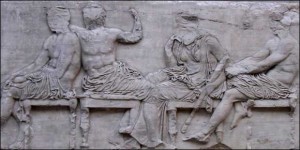 [Click to Enlarge ]Reclining gods on the Parthenon frieze London (British Museum) (Picture originally posted in Iran Chamber Society).
[Click to Enlarge ]Reclining gods on the Parthenon frieze London (British Museum) (Picture originally posted in Iran Chamber Society).
Both reliefs are tripartite, and the central parts are the most important. The other two parts, flanking the central composition, also show strong similarities. At the extreme ends, we see the last partakers in the processions, e.g., horses and other animals. There is much space allotted to them. More to the center, the people become more quiet, are placed closer to each other. Here, turned heads or stretched arms are the only visible actions. The central panel, where Darius and Xerxes or the basileus and basillina are visible, is larger and more spacious. This composition forces, so to speak, the spectator to look to the center of the relief.
It is possible to make another tripartite division. In both works of art, the picture is that of a central figure, an entourage surrounding him, and people approaching him. (In the Parthenon frieze, the entourage consists of gods and the folding of the peplos.)
Another resemblance is their placing: they are both situated on the spot where the ceremonies actually happened. This must have caused a special effect. The Athenian spectator was not just looking at a beautiful picture with an obvious symbolism, but recognized something that he had experienced himself. The Persepolis relief created a similar involvement of the spectator, although at a larger scale. But those who saw the relief on the Apadana, knew instinctively that they belonged to this procession of subjects, belonged to the Achaemenid empire, and had to contribute to its strength. This solidarity was of course what the great Achaemenid empire, or any nation that wanted to be great, needed. Of course, the depicted unitedness -social and political in Persia, religious in Athens- was not necessarily real, but an ideal.
The Parthenon is not a pure religious building. The frieze is also a political statement, inviting the citizens to remain united. But this is not the only message. Elsewhere, on the metopes, we can see a battle between Amazons (dressed as Persians) and Greeks that is usually interpreted as a mythological reference to the war between Athens and Persia, and a deep insult to the Persians, who could not be offended more than by being called “woman”. We can also see gods fighting against giants, Greeks against centaurs, and Achaeans against Trojans. (Similar representations of the war between the powers of chaos and order can be found in Persepolis, where we find pictures of a bull and lion.) All this served to present the Athenians as valiant warriors, the equals of the gods and the legendary heroes.
The Parthenon also had a function as treasury of the Delian League and a reserve fund. For example, every tributary town was supposed to send an ambassador to the Panathenaea and offer a cow and a coat of arms. This was again similar to the Persian example, because one of Persepolis’ main functions was that of treasury. Both buildings, Apadana and Parthenon, were an empire’s focus points of politics, religion, and finance, and it is possible that Athenian artists had learned from their older Ionian colleagues how the great king had invited his subjects to be his collaborators.
Architecture: Erechtheum
Another example of the emulation of artistic ideas can be found in the Erechtheum on the Athenian acropolis. It was built after the Parthenon, between 425 and 409 BCE, during the war against Sparta. For the present purpose, we are interested in only one part of this complex sanctuary: the caryatids.
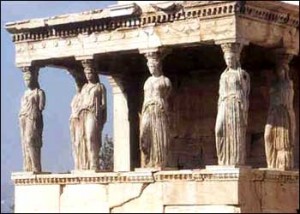 Athenian caryatids (Picture originally posted in Iran Chamber Society).
Athenian caryatids (Picture originally posted in Iran Chamber Society).
In one of the wings of the Erechtheum, these female figures carry the roof on their heads. They are not the first examples of thus type of column in Greece: the caryatids of the Siphnian treasury at Delphi were, according to some art historians, erected after the Greek victory over the Persians in 479 BCE.
The issue is how and from where these women were introduced into Greek art. One explanation is offered by Vitruvius, a Roman architect who published a textbook On architecture. He writes:
Should any one wish for information on the origin of those draped matronal figures […] called caryatids, I will explain it by the following story. Carya, a city of Peloponnese, joined the Persians in their war against the Greeks. These in return for the treachery, after having freed themselves by a most glorious victory from the intended Persian yoke, unanimously resolved to launch a war against the Caryans. Carya was taken and destroyed, its male population extinguished, and its matrons carried into slavery. To ensure that these circumstances might be better remembered, and the nature of the triumph perpetuated, the victors represented the matrons draped, and apparently suffering under the burden with which they were loaded, to expiate the crime of their native city. Thus, in their edifices, did the ancient architects, by the use of these statues, hand down to posterity a memorial of the crime of the Caryans. [Vitruvius, On architecture 1.1.5]
In other words, caryatids are not only statues with the function of columns, but express an idea: you were not supposed to collaborate with the enemy, because you would be subdued, humiliated, and punished.
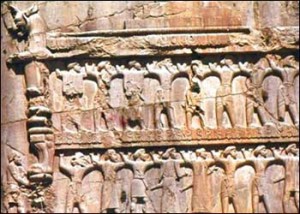 The Naqshe Rustam relief (Picture originally posted in Iran Chamber Society).
The Naqshe Rustam relief (Picture originally posted in Iran Chamber Society).
This motif is also known from Persia. In the second half of the sixth century BCE, the great king had assembled a great many conquered nations. These people, or rather their subjection, became part of the royal imagery.
To express the idea that others were subjected, the Persians used no human but animal figures. For example, the imposts of the columns in the palaces (the top of a column which connects it with the supporting beams of the roof) often have the shape of of a bull or a winged feline. The analogy is obvious: like a griffin or a wild bull under a yoke, the nations were kept under control by the king.
Sometimes, humans are depicted as carriers of a great weight: for example, on the royal tombs at Naqš-i Rustam, we see the king, standing on two large platforms. These platforms are carried by men, who probably resemble the subject nations. Another example is the representation of the king on the tripylon-gate at Persepolis, where the king is sitting on a throne, supported by three levels of humans.
The Athenian caryatids do not resemble Athenian women: their hair cuts are uncommon and resemble Peloponnesian hair cuts. This is something we can say with certainty. It is tempting to look for a Persian antecedent for the caryatids, because there are no obvious antecedents in Greek art. But when we try to establish a Persian influence, we have to be more speculative. Why didn’t the Athenians copy the animal figures and did they use women instead?
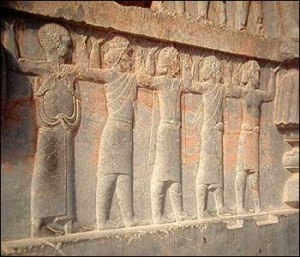 Relief from Persepolis (Picture originally posted in Iran Chamber Society).
Relief from Persepolis (Picture originally posted in Iran Chamber Society).
If we ignore the possibility that the Athenian men treated their women like animals -which is certainly a possible interpretation- the solution may be that the Athenians only emulated the general idea behind the representation. In the Persian context, yoked animals or people are carrying a great weight, which was apparently seen as the essence of subjection. The same element can be found in the Greek situation: the caryatids are carrying a heavy load. This time, they are not animals but women, but this has a reason: as we have seen in the example of the Parthenon frieze (above), the Athenians adapted a general idea to a specific situation. They used a concrete example, the shameful subjection of the women of Carya, to show that they were prepared to subject people, as the Persians did.
This was not merely an intention, but the Athenians put it into practice. In the next section, we will deal with their imperialist policy. In the years after the Persian Wars, Athens expanded its empire and controlled a great part of the Greek world with its superior navy. This created new problems in the management of the empire, and the Athenians wanted to deal with them as efficiently as possible. Probably, they looked abroad how the Achaemenid empire had solved the same problems. Of course it is possible that the Athenian leaders were original and creative thinkers, but, as we shall see in the next parts of this article, there are indications that they copied Persian solutions.
Politics
As we have seen above, Athens brought the war against the Persians to a good ending and discovered the opportunities offered by the Delian League. As long as the war against Persia had been going on, its members had had every reason to remain united, but now that the immediate cause was removed, Athens had to look for a tool to keep its nascent empire together.
Member states that wanted to segregate from the League, were brutally attacked. The smaller city states, which could use some help and protection, were inclined to side with Athens, but others, which hated to pay tribute and the increasing Athenian involvement in their internal affairs, were visited by the Athenian navy and forced into surrender (e.g., Naxos in 470 and Thasos in 465 BCE). These towns, which had been forced to remain in the League, had another status than the cities that obeyed Athens. They had to disband their navies, had to pay tribute in cash, and lost much of their autonomy. If they were not democratic, they were forced to change their constitution.
At a later stage, towns that had always paid their tribute in cash were equaled with the subject cities. The number of autonomous cities diminished. When the Peloponnesian War broke out in 431 BCE, only Chios and Lesbos had retained some of their former independence.
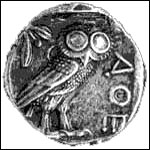 Athenian coin (Picture originally posted in Iran Chamber Society).
Athenian coin (Picture originally posted in Iran Chamber Society).
But it was not only military power that helped Athens become the master of a great part of Greece; its economic power was a source of strength as well. The Athenian port was the center of interregional commerce and the city had commercial treaties with many towns and nations inside and outside the League. It controlled the monetary system and ordered that only the famous Athenian ‘owl’-coins and weights were to be used in commercial transactions.
Athens also founded colonies (cleruchies). These were meant to repopulate subject towns from which a part of the population had been expelled. This gave the Athenians a stronghold in potentially unquiet areas, because the colonists retained their Athenian citizenship and did not have to pay tribute. After 450 BCE, Athens started to station garrisons throughout its empire.
Every town in the Athenian empire, whatever its precise status, was supervised by an episcopus or overseer. This Athenian magistrate kept an eye on the town where he resided. He controlled the payment of the tributes, was supposed to prevent insurrections and had to investigate evils and report them to the government at home.
All in all, the Delian League was a complex organization. We will now investigate whether the organization of the Achaemenid empire served as a model to the Athenian empire, and we will concentrate on the following aspects:
- the organization of the League, and its resemblances with and its differences from the structure of the Persian state, and especially the way tribute was paid.
- the function and origin of the office of the episcopus.

